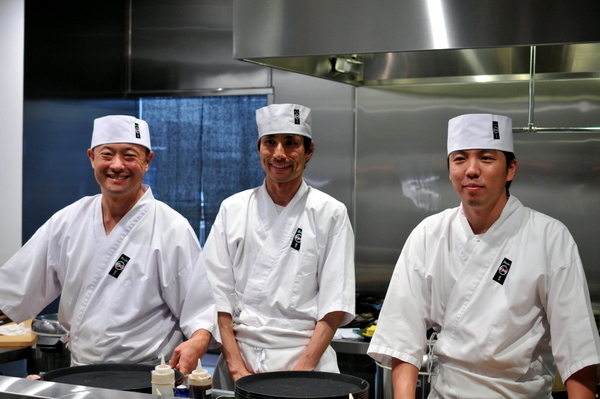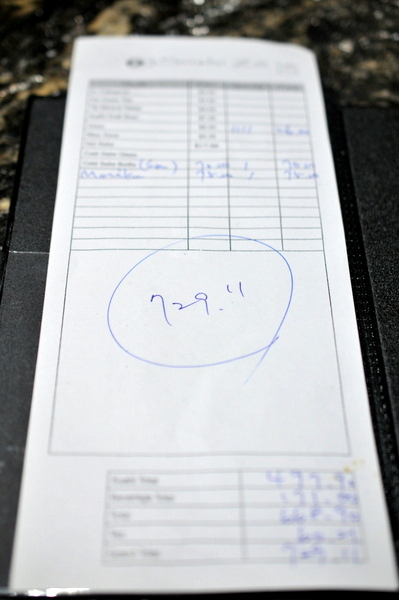334 S Main St
Los Angeles, CA 90013
(213) 935-8409
Rumblings about a new Sushi Zo since late last year. The original Palms location earned a reputation as one of the area's top sushi restaurants on the strength of its pristine cuts of fish and the use of loosely packed warm rice. The new omakase-only restaurant, simply dubbed Zo, was originally slated to open in June but the inevitable delays associated with opening a new restaurant delayed things for a few months. Located on the first floor of The Medallion, a mixed use apartment and retail building, the space has a airy clean contemporary feel.
Despite having just opened in mid September, early news about the restaurant has been quite positive. Not only is the food comparable to the old location, but if the rumors are to be believed the owner and head chef Keizo Seki has mellowed in his old age, becoming friendlier and less intimidating.

Kumamoto Oyster
The meal started with a dainty Kumamoto. Dense and compact with a creamy lushness on mastication, the oyster was on the sweet side especially once the tang of the ponzu came into play.

Mebachi - Big Eye Tuna
Next up were for thick pieces of Big Eye tuna. The flesh was a tactile joy weighty yet yielding to the bite, a generous brush of potent soy and bite of the wasabi provide most of the flavor.

Awabi - Abalone
Moving on, my companions and I shared an abalone. The meat was cut into thick chunks giving it a dense rigidity that takes a bit of effort to bite through. The accompanying yuzu kocho is fairly intense, at once salty with a fair amount of heat.

Ika Somen - Squid Noodles with Sea Urchin and Truffle Salt
I could smell the aroma of truffle as soon as this dish was set before me. In fact my only nitpick with this dish was the intensity of the truffle. I didn't expect the squid to be particularly flavorful but I would have liked the flavor of the uni to be more apparent. Instead the truffle was the pervading flavor while the uni provides an underlying savory sweetness.

Jellyfish - White Miso Vinaigrette
This was one of the few new dishes and it was a very welcome addition. The translucent jellyfish was simultaneously snappy yet slick. The white miso comes on a bit strong but I was still able to detect a gentle salinity under the sauce.

Hirame - Halibut
The appetizers dispensed with, we moved on to the nigiri. First up was a tender sliver of halibut that dissolved on the tongue leaving behind a melange of sweet nuttiness tinged with a bright acidity.

Binaga - Albacore
Next up was a beautiful pink tinged flesh was even softer than the halibut and loaded with subtly sweet oiliness. The nigiri came seasoned with a sharply contrasting ponzu and the spicy bite of ginger.

Hamachi - Yellowtail
The Hamachi came served in classic fashion with little more than soy and wasabi. The simple flavors worked well to highlight the tender flesh and the lush oily savor.

Aji - Spanish Mackrel
A fantastically balanced example of Aji, the fish had a pleasing firmness and a moderate flavor. I noted a strong onion-y zest from the chives that complimented the clean savor of the fish.

Hotate - Scallop
This was a textbook scallop with plenty of sweet salinity and a jellied firmness that evolves into a creamy slightly tacky mouthfeel upon mastication.

Chu-Toro - Medium Fatty Tuna
As always the toro is the only nigiri that comes as a pair. The toro came from the same Big Eye Tuna as the Akami sashimi we had earlier in the meal. Instead of the clean even texture of the lean tuna, the belly has a porous almost pillow-y feel and seems to exude a rich fishiness. I wonder if the absence of Bluefin is a conscious decision to go with a more sustainable fish or driven by more practical reasons like cost or quality.

Koban Aji - Pompano with Shishito Pepper
Pompano is a relative rarity at sushi restaurants that I've only seen before at Nana-san in Newport Beach. In contrast with my previous experience, this piece ran towards the milder side relying on the roasted shishito's fantastic bitter vegetal savor.

Kampachi - Amberjack
A close cousin of the Yellowtail we had earlier, the Amberjack was much leaner with a markedly firmer texture with clean lines running between the individual segment. The flavor was similarly more subdued with a lightly sweet twang complimenting the whisper of oil.

Kinmedai - Golden Eye Snapper
My first run in with this fish was at the original Sushi Zo way back in 2008 and I don't think I've had a bad piece since. Still a relative rarity, the fish is generally confined to higher end restaurants. Unlike the more ubiquitous Red Snapper, the Golden Eye is threaded with fine white lines of fat and has a correspondingly richer flavor with a lingering buttery finish.

Ankimo - Monkfish Liver
This was the first real misstep of the night. I don't know if it was slightly cooked by the heat from the fresh batch of warm rice or just an odd piece but the liver had a rather dry texture and pronounced egginess to it. One of my companions said it reminded him of Jack in the Box tacos.

Sanma - Pike Mackerel
Another relative rarity, I can only recall having this a handful of times whether seared or raw this is one of the most intensely flavored fishes around. Under the delicately scored steely blue skin there was a thick snowy layer of white fat with rich red lean meat underneath. The high fat content makes the Mackerel gives it an intensely soft texture and rich oily gravitas that feels almost steely on the finish.

Tara - Butterfish with White Miso
This was a very lightly seared slice of butterfish, the fish is still effectively raw with a supple creamy texture but not much intrinsic flavor giving the sweet white miso sauce had free reign. Though I typically prefer my meat as raw as possible, I think a bit more searing would have been effective here to give the fish a bit of smokiness.

Kurodai - Black Snapper with Truffle Salt
The truffle salt makes another appearance this time on top of a sliver of supple jellied Black Snapper. The fish's intrinsic flavor is masked by the pungent truffle to start but I did detect a slightly sweet flavor on the finish.

Tako - Octopus with Eel Sauce
The octopus came steamed giving it a soft tenderness as well as a light ham like smokiness. The smear of thick brown sauce is Tare, a sauce normally reserved for eel but that worked very effectively here taking on an almost caramel like character in combination with the eel.

Sawara - King Mackerel
Sometimes also referred to as Spanish Mackerel, this isn't the more popular version found at almost every sushi restaurant. Instead the sawara has a drier more segmented texture with a sweet oily savor.

Mirugai - Geoduck
Next up was a generous slab of crunchy giant clam. The meat has a twinge of earthiness mixed in with the typical salinity. The minimal adornment lets the natural flavor of this little ivory gem shine.

Sumi Ika - Ink Squid
I've seen this translated as cuttlefish, but our itamae referred to it as Ink Squid. In contrast to the more common ika, the Sumi Ika's texture doesn't break down into the typical creamy feel but remains dense and distinct.

Madai - Red Snapper
Madai commonly appears early in the meal so I was a bit surprised to see it here. The fish is dusted with a bit of salt and finished with a squeeze of yuzu. The salty twang of the fish is finished with brief flashes of wasabi heat on the finish.

Shima Aji - Striped Jack
Typically one of my favorite fishes, the Shima Aji was delicious but had lots of stiff competition here. The fish looked a lot like the hamachi we had earlier but with a more sophisticated blend of sweetness and oily savor.

Amaebi - Sweet Shrimp
Next up was a beautifully translucent live sweet shrimp. The piece displays a short lived snap but becomes soft and creamy as it warms. A light brush of soy highlights the shrimp's natural salinity.

Uni - Sea Urchin
Ikura - Salmon Eggs
Next up was a duo of roe. Masa recommended we start with the San Diego uni, the golden roe liquifies immediately becoming a cool sweet slurry of rich offal-tinged majesty. The marinated salmon eggs were cool and snappy. Popping the little globules releases a rush of cool lightly smoky liquid that reminded me of a chilled dashi.

Anago - Sea Eel
When I saw the Anago I knew this meal was winding down. The warm Anago almost breaks down immediately as soon as its popped in the mouth. The eel has a clean savor to it mixed with the sweetness of the accompanying sauce.

Sake - Salmon with Marinated Kelp
A fairly pedestrian piece of fish, Masa seemed almost reluctant to serve this to us but we kept asking if there was anything we hadn't tried. The Scottish Salmon runs towards the sweet side thanks to the translucent sliver of jammy sweet kelp and the lack of soy.

Madai - Young Red Snapper
The final piece of the night was a lightly boiled red snapper. The texture felt much more pronounced than the adult snapper's. The mild flesh had a slight savor touched with the clean acidic twang of lemon.

Chu-Toro Temaki - Medium Fatty Tuna Hand Roll
Masa asked if we were still hungry and when we said that we were he immediately started working on some hand rolls for us. In contrast to the rest of the meal we were responsible for seasoning the rolls ourselves. I was a bit heavy handed with my first bite but the roll definitely needs some soy to bring out its full potential.

Kani Temaki - Blue Crab Hand Roll
The final savory dish of the night was a generously filled blue crab hand roll. The shredded crab meat comes in a lightly creamy sauce. Delicious on its on though, sparing dabs of soy also work very effectively with the vibrantly sweet shellfish.

Tamago - Egg
Having eaten every type of fish the restaurant had on hand we reluctantly signalled an end to the meal. As always the finalThe egg was on the savory side with a pronounced hamminess coupled with a light syrupy sweetness.

Yuzu Juice
It wouldn't be a real meal at Zo without a shot of sweet yuzu juice to refresh the palate. The small shot is just enough to do the job but always leaves me wanting more.

I've heard that with the new Zo comes a nicer Keizo and our interactions with him throughout the meal seem to bear out that assertion. Though he wasn't our itamae, I noticed him laughing and joking with the guests in front of him he checked in on us periodically throught the meal and even smiled for the picture at the end. Our chef was Masa the young man on the far right of the photo who used to work at Nana-san in Orange County (perhaps the impetus for adding pompano to the menu). In the middle was Yuji who assisted Masa through much of the service.

For veterans of the original Sushi Zo much of the food will be familiar though with perhaps a touch more precision. While the food might not be particularly different, the atmosphere is markedly improved. Where the old Zo could feel a bit intimidating in the same way that Nozawa did, Zo 2.0 seems to make every effort to set diners at ease from the frendlier chefs to the more relaxed pace between pieces of nigiri. In summary, the new Zo does everything the old one did and more; the quality of fish makes the meal one of LA's premier omakases but with a touch more refinement and attention paid to the overall experience.

Sunday, October 13, 2013
Zo - 10/11/2013
Subscribe to:
Post Comments (Atom)

11 comments:
Price per person?
It was $295 per person with tax and tip, but that included four beers and two bottles of sake
So roughly $200pp sans drinks?
Closer to $225pp but we did eat every type of fish the restaurant has on offer.
Can you suggest me a sushi restaurant (omakase) that's roughly $100-120~pp before tax/tip?
Thanks!
Sumi ika is not firefly squid. Apparently it can refer to two different type of squid, according to this site: http://www.romajidesu.com/dictionary/meaning-of-sumiika.html
I've also heard it referred to as sepia squid, since "sumi" means (squid) ink in Japanese.
Firefly squid is hotaru ika, which if served nigiri form would require one or more whole squid, since they are rather small, to cover the rice.
@Anonymous, there are plenty of places that serve omakase at $100-$120/pp. You can always make a request of the itamae, or call ahead. My own personal favorites are Shunji and Kiriko in West L.A. Both also offer incredibly inexpensive omakase-like lunch specials ($40 for 12 or 9 pieces of nigiri at Shunji or Kiriko, respectively, plus a hand roll).
Anonymous,
Depends how much you eat. If you are looking to get 25-30 pieces per person that probably eliminates the top tier like Zo or Mori. Sushi Nozomi in Torrance might get you close or if you are willing to head to Orange County, I think Ohshima would fit the bill nicely.
If you are open to Kaiseki and not just nigiri sushi, N/Naka has a $110pp 9-course menu. Nana-San in OC offers a very good kaiseki at a sub $100 price.
I will also echo The Offalo's comment you can let them know how much you want to spend and they'll take care of the rest.
Offalo,
Good catch. I actually had it as ink squid in my notes and I sort of remember the chef saying something similar.
OC is definitely a possibility. Me and my girlfriend can eat a lot so which place would be the best bang for buck, a nigiri focused omakase or kaiseki meal?
Offalo: if you had to choose between Shunji and Kiriko, where would you go?
I think probably nigiri focused. Ohshima would probably fit your budget. Here is a post with 30+ for under 240. Keep in mind this was 2 years ago so prices have probably gone up. If you do go I recommend getting reservations for bar seats, sushi at the table is a very different experience. Be warned they only take reservations between 5:00 and 5:30 and max 2 people for the sushi bar. Pacing can also be slow on busy nights so I'd pick a weekday or go for lunch if you can.
http://tangbro1.blogspot.com/2011/12/oshima-12232011.html
I know you asked Offalo, but I would pick Shunji. I did their $200 omakase earlier this year
http://tangbro1.blogspot.com/2013/03/shunji-03162013.html
Thanks for the suggestions. I'll check out Ohshima. My OC sushi adventures have been mixed. I went to Shunka and really enjoyed it. Ikko on the other hand was a very big let down.
@Anonymous, like Ryan I would pick Shunji as well. I've reviewed it numerous times on my blog too. They have a set $100 Japanese tasting menu too, if you want to have the peace of mind of having a fixed cost without having to negotiate a price.
Post a Comment